

Muscovy Duck. The Muscovy Duck (Cairina moschata) is a large duck native to Mexico, Central, and South America.

Small wild and feral breeding populations have established themselves in the United States, particularly in the lower Rio Grande Valley of Texas, as well as in many other parts of North America, including southern Canada. Feral Muscovy Ducks are found in New Zealand and have also been reported in parts of Europe. They are a large duck, with the males about 76 cm or 30 inches long, and weighing up to 7 kg or 15 pounds. Females are considerably smaller, and only grow to 3 kg or 7 pounds, roughly half the males' size.
Pomeranian duck. Pomeranian Ducks The Pomeranian duck (in German Pommernente) is a breed of domesticated duck.
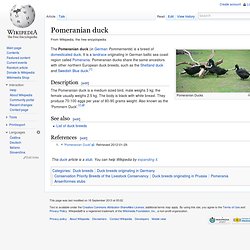
It is a landrace originating in German baltic sea coast region called Pomerania. Magpie Duck. A typical Magpie Duck.

The Magpie Duck is a lightweight breed of domesticated duck. Developed in the early 20th century, they are raised as general purpose ducks, since they have attractive markings, and are highly productive layers of large eggs. Scientific Name[edit] Anas platyrhynchos domesticus. Silver Appleyard Duck. Description[edit] The Silver Appleyard Duck is a "large, sturdily built duck" with a "blocky" physique and a prominent breast.
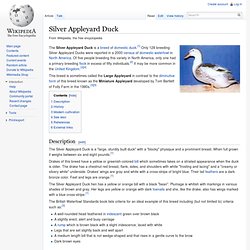
When full grown it weighs between six and eight pounds.[1] Drakes of this breed have a yellow or greenish-colored bill which sometimes takes on a striated appearance when the duck is older. The drake has a chestnut red breast, flank, sides, and shoulders with white "frosting and lacing" and a "creamy or silvery white" underside. Drakes' wings are gray and white with a cross-stripe of bright blue. The Silver Appleyard Duck hen has a yellow or orange bill with a black "bean". The British Waterfowl Standards book lists criteria for an ideal example of this breed including (but not limited to) criteria such as:[3] History[edit] The Silver Appleyard is named after Reginald Appleyard, the breeder who developed it at his Priory Waterfowl Farm[1] near Bury St Edmunds, England.
Modern cultivation[edit] According to the American Livestock Breeds Conservancy: See also[edit] Swedish Blue duck. Swedish Blue Ducks The Swedish Blue duck (in Swedish Svensk blå anka) is a breed of domesticated duck.
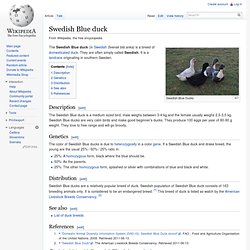
They are often simply called Swedish. It is a landrace originating in southern Sweden. Description[edit] The Swedish Blue duck is a medium sized bird, male weighs between 3-4 kg,and the female usually weighs 2,5-3,5 kg. Genetics[edit] The color of Swedish Blue ducks is due to heterozygosity in a color gene. 25%: A homozygous form, black where the blue should be.50%: As the parents.25%: The other homozygous form, splashed or silver with combinations of blue and black and white. Cayuga Duck. Cayuga drake A Cayuga Duck is a medium-class domesticated duck breed that has been a popular variety in the USA since the mid-19th century.
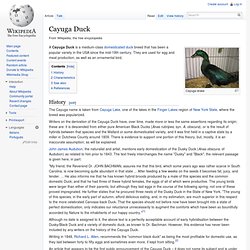
They are used for egg and meat production, as well as an ornamental bird. History[edit] The Cayuga name is taken from Cayuga Lake, one of the lakes in the Finger Lakes region of New York State, where the breed was popularized. Writers on the derivation of the Cayuga Duck have, over time, made more or less the same assertions regarding its origin; these are: it is descended from either pure American Black Ducks (Anas rubripes; syn. John James Audubon, the naturalist and artist, mentions early domestication of the Dusky Duck (Anas obscura, of Audubon) as related to him prior to 1843. "My friend, the Reverend Dr. Although no date is assigned to it, the above text is a perfectly acceptable account of early hybridisation between the Dusky/Black Duck and a variety of domestic duck, as known to Dr. Writing in 1848, Richard L.
The large size of Mr. Mr. Ancona duck. Ancona Ducks The Ancona Duck is a breed of domestic duck.

These rare ducks[1] are considered to be a descendant of the Indian Runner Duck and the Belgian Huttegem Duck breeds. It has been stated Anconas were developed in England during the early 20th century, but were not available in the United States until 1984.[2] However, the Ancona Duck was present in the USA in 1911 and was exhibited at major Poultry Shows for many years after this date. The original Ancona Duck occurred only in a black & white variety and laid a pure white egg.[3][4] Appearance[edit] See also[edit] Golden Cascade. Golden Cascade female The Golden Cascade is a breed of domestic duck developed in the United States.
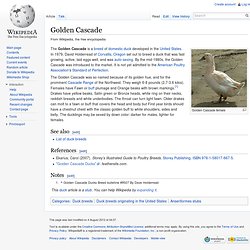
In 1979, David Holderread of Corvallis, Oregon set out to breed a duck that was fast growing, active, laid eggs well, and was auto-sexing. By the mid-1980s, the Golden Cascade was introduced to the market. It is not yet admitted to the American Poultry Association's Standard of Perfection.